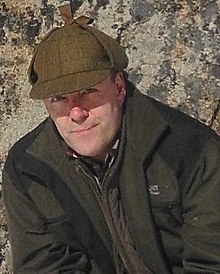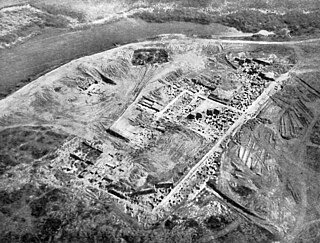
Sarkel was a large limestone-and-brick fortress in what is now Rostov Oblast of Russia, on the left bank of the lower Don River.

Eric the Victorious was a Swedish monarch as of around 970. Although there were earlier Swedish kings, he is the first Swedish king in a consecutive regnal succession, who is attested in sources independent of each other, and consequently Sweden's list of rulers usually begins with him. His son Olof Skötkonung, however, is considered the first ruler documented to definitely have been accepted both by the original Swedes around Lake Mälaren and by the Geats around Lake Vättern. Adam of Bremen reports a king named Emund Eriksson before Eric, but it is not known whether he was Eric's father. The Norse sagas' accounts of a Björn Eriksson are considered unreliable.
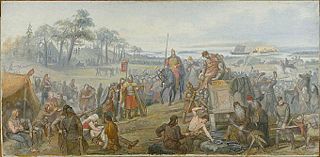
Fyrisvellir, Fyris Wolds or Fyrisvallarna was the marshy plain (vellir) south of Gamla Uppsala where travellers had to leave the ships on the river Fyris (Fyrisån) and walk to the Temple at Uppsala and the hall of the Swedish king.
Fagrskinna is one of the kings' sagas, written around 1220. It is assumed to be a source for what is known as the Heimskringla, containing histories of Norwegian kings from the 9th to 12th centuries, as well as skaldic verse.
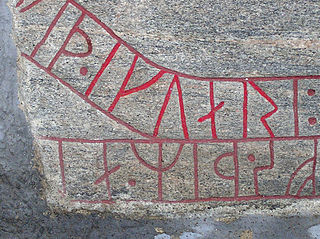
Ingvar the Far-Travelled was a Swedish Viking who led an expedition that fought in the Kingdom of Georgia.
In Old Norse sources, such as sagas and runestones, Serkland was the "land of the Serkir", usually identified with the Saracens.
Hulda-Hrokkinskinna is one of the kings' sagas. Written after 1280, it relates the history of the Norwegian kings from Magnús góði, who acceded to the throne in 1035, to Magnús Erlingsson, who died in 1177.

Morkinskinna is an Old Norse kings' saga, relating the history of Norwegian kings from approximately 1025 to 1157. The saga was written in Iceland around 1220, and has been preserved in a manuscript from around 1275.

The Caspian expeditions of the Rus' were military raids undertaken by the Rus' between the late 9th century and c. 1041 on the Caspian Sea shores, of what are nowadays Iran, Dagestan, and Azerbaijan. Initially, the Rus' appeared in Serkland in the 9th century traveling as merchants along the Volga trade route, selling furs, honey, and slaves. The first small-scale Viking raids took place in the late 9th and early 10th century. The Rus' undertook the first large-scale expedition in 913; having arrived on 500 ships, they pillaged in the Gorgan region, in the territory of present-day Iran, and more to the west, in Gilan and Mazandaran, taking slaves and goods. On their return, the northern raiders were attacked and defeated by the Khazars in the Volga Delta, and those who escaped were killed by the local tribes on the middle Volga.

In the Middle Ages, the Volga trade route connected Northern Europe and Northwestern Russia with the Caspian Sea and the Sasanian Empire, via the Volga River. The Rus used this route to trade with Muslim countries on the southern shores of the Caspian Sea, sometimes penetrating as far as Baghdad. The powerful Volga Bulgars formed a seminomadic confederation and traded through the Volga river with Viking people of Rus' and Scandinavia and with the southern Byzantine Empire Furthermore, Volga Bulgaria, with its two cities Bulgar and Suvar east of what is today Moscow, traded with Russians and the fur-selling Ugrians. Chess was introduced to Medieval Rus via the Caspian-Volga trade routes from Persia and Arabia.
Háttalykill inn forni, also known in short as Háttalykill, is an Old Norse poem, attributed to Rögnvaldr Kali Kolsson of Orkney and Hallr Þórarinsson in the Orkneyinga Saga. The poem survives only in late manuscripts. The form of the poem is mainly greppaminni, principally a form of questions and corresponding answers. The style is vernacular.
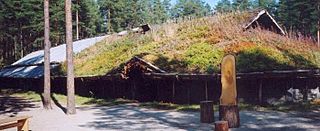
Gene Fornby is a reconstructed Iron Age settlement just outside Örnsköldsvik, in Västernorrland County, Sweden.

The Danish Census Book or the Danish book of land taxation dates from the 13th century and consists of a number of separate manuscripts. The original manuscripts are now housed in the Danish National Archives (Rigsarkivet) in Copenhagen.

Johan Hadorph was a Swedish director-general of the Central Board of National Antiquities.

Astrid Olofsdotter was the queen consort of King Olaf II of Norway.
Eirspennill, also known as AM 47 fol, is a medieval manuscript which contains copies of four sagas: Heimskringla, Sverris saga, Böglunga sögur, and Hákonar saga Hákonarsonar. The manuscript is considered to date to the early 14th century, and a marginal note within states that in the mid 14th century it belonged to Þranðr Garðarson, Archbishop of Nidaros. The manuscript is believed to have been compiled by two Icelanders.

Codex Frisianus or Fríssbók is a manuscript of the early fourteenth century. Among its 124 folios, it contains Heimskringla and Hákonar saga Hákonarsonar.
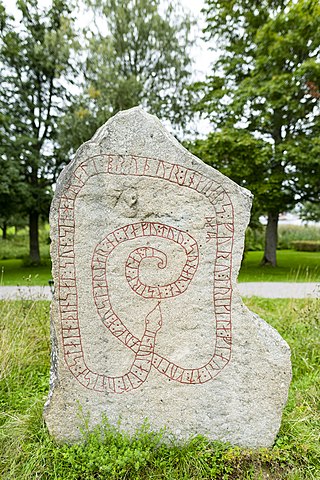
The Ingvar expedition is the Swedish Viking Age event that is mentioned on a large amount of preserved runestones. About twenty-six Ingvar runestones in Sweden refer to Swedish Viking warriors who travelled east with Ingvar on his expedition to Serkland, or the Saracen lands. The expedition started in the second half of the 1030s and ended catastrophically in the year 1041, according to several Icelandic Annals, and was later the object for an Icelandic saga in the 12th century; the Yngvars saga víðförla. The Ingvar expedition seems to have been organized mainly on the basis of today's Svealand. King at the time was Anund Jakob. One of the most famous of the Ingvar runestones is the Gripsholm Runestone. Its inscription tells that it was raised in honour of Ingvar’s brother Haraldr who had died in Serkland.

Bautil is a fundamental Swedish runological work by the priest, runologist and archaeologist Johan Göransson, published in 1750.

Västernorrland County Museum is the regional museum of Västernorrland County, Sweden. One of Sweden's 24 county museums, Västernorrland County Museum has the aim to preserve and transmit the cultural history of Västernorrland. The collections are based on history, archaeology, ethnology, culture and art. The museum's head office is currently located at Härnösand in Härnösand Municipality. Among the museum's many activities, the extensive exhibition activities are one of the most important. Other very important activities concern the preservation of old buildings and the care of the county's cultural heritage environments and archaeological sites, a work that is carried out in collaboration with the County Administrative Board of Västernorrland. The museum serves all inhabitants in the county. It documents both prehistorical and historical structures in the county and promotes the visiting of them. The current museum director is Jenny Samuelsson and the current chairman is Carl L. Thunberg. Among the areas covered by the museum is the UNESCO World Heritage Site of the High Coast area.
